Analyzing the Economic Viability of Wind Turbines in Canada
VerifiedAdded on 2023/06/10
|7
|1801
|118
Report
AI Summary
This report examines the economic viability of wind turbines in Canada, considering their mechanics, advantages, and future prospects. It discusses the conversion of wind's kinetic energy into electrical energy and Canada's wind energy penetration. The report also analyzes the economics of wind energy, highlighting the cost benefits, technological advancements, and job creation. It further explores the environmental economics of wind power, comparing its impact to fossil fuels, and concludes that wind energy is an economically viable option for electricity generation in Canada. Desklib offers a platform to access similar assignments and study tools.
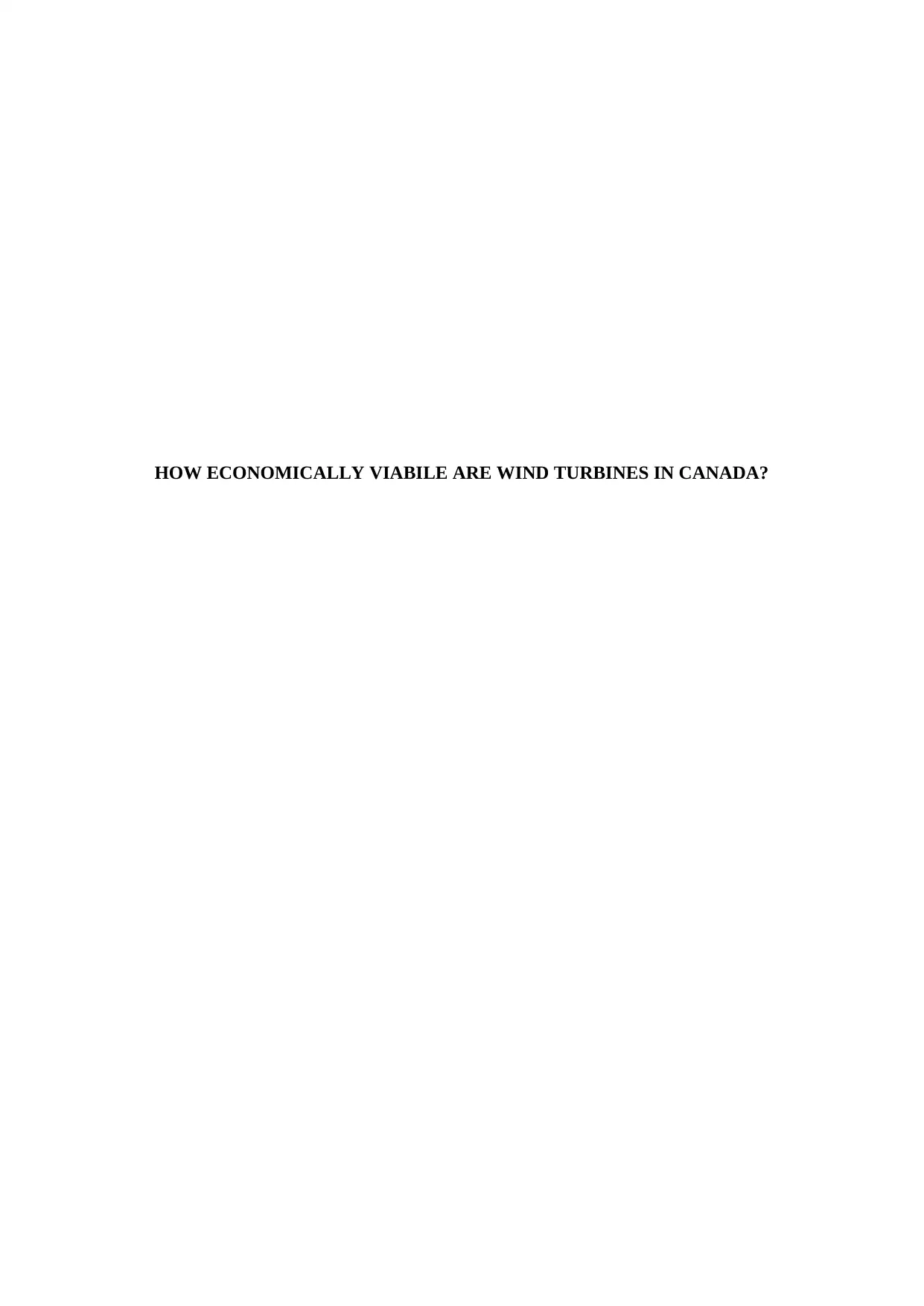
HOW ECONOMICALLY VIABILE ARE WIND TURBINES IN CANADA?
Paraphrase This Document
Need a fresh take? Get an instant paraphrase of this document with our AI Paraphraser

Wind Energy in Canada
HOW ECONOMICALLY VIABILE ARE WIND TURBINES IN CANADA?
Introduction
Wind power is the method of generating energy by utilizing the flow of wind via
turbines. Turbines are specialized devices designed generate electrical energy by converting
the kinetic energy provided by the wind into mechanical power (Manwell, McGowan and
Rogers). This power is an excellent alternative to burning fossil fuels to generate electricity.
One of the major advantages of using wind power is that it is renewable, and is
environmental friendly. The amount of energy generated is variable, depending on the wind
flow. Economically, the initial costs of setting up a wind energy project would be high; it
would be balanced in subsequently as there is no cost for wind, which is the main input
source.
In Canada, Wind energy is the most preferred source, as it generates “clean energy”,
and thus has attracted a huge chunk of investments in the past year. As it has greater
advantages over non-renewable energy sources, many countries including Canada provide
incentives to industries setting up wind turbines, in order to encourage the use of wind power.
However, there are many considerations to be made before embarking on such a huge project
(Holburn, Lui and Morand 465). The factors influencing the economic viability of wind
energy, its mechanics, and the future of wind energy in Canada are discussed in this essay.
2
HOW ECONOMICALLY VIABILE ARE WIND TURBINES IN CANADA?
Introduction
Wind power is the method of generating energy by utilizing the flow of wind via
turbines. Turbines are specialized devices designed generate electrical energy by converting
the kinetic energy provided by the wind into mechanical power (Manwell, McGowan and
Rogers). This power is an excellent alternative to burning fossil fuels to generate electricity.
One of the major advantages of using wind power is that it is renewable, and is
environmental friendly. The amount of energy generated is variable, depending on the wind
flow. Economically, the initial costs of setting up a wind energy project would be high; it
would be balanced in subsequently as there is no cost for wind, which is the main input
source.
In Canada, Wind energy is the most preferred source, as it generates “clean energy”,
and thus has attracted a huge chunk of investments in the past year. As it has greater
advantages over non-renewable energy sources, many countries including Canada provide
incentives to industries setting up wind turbines, in order to encourage the use of wind power.
However, there are many considerations to be made before embarking on such a huge project
(Holburn, Lui and Morand 465). The factors influencing the economic viability of wind
energy, its mechanics, and the future of wind energy in Canada are discussed in this essay.
2
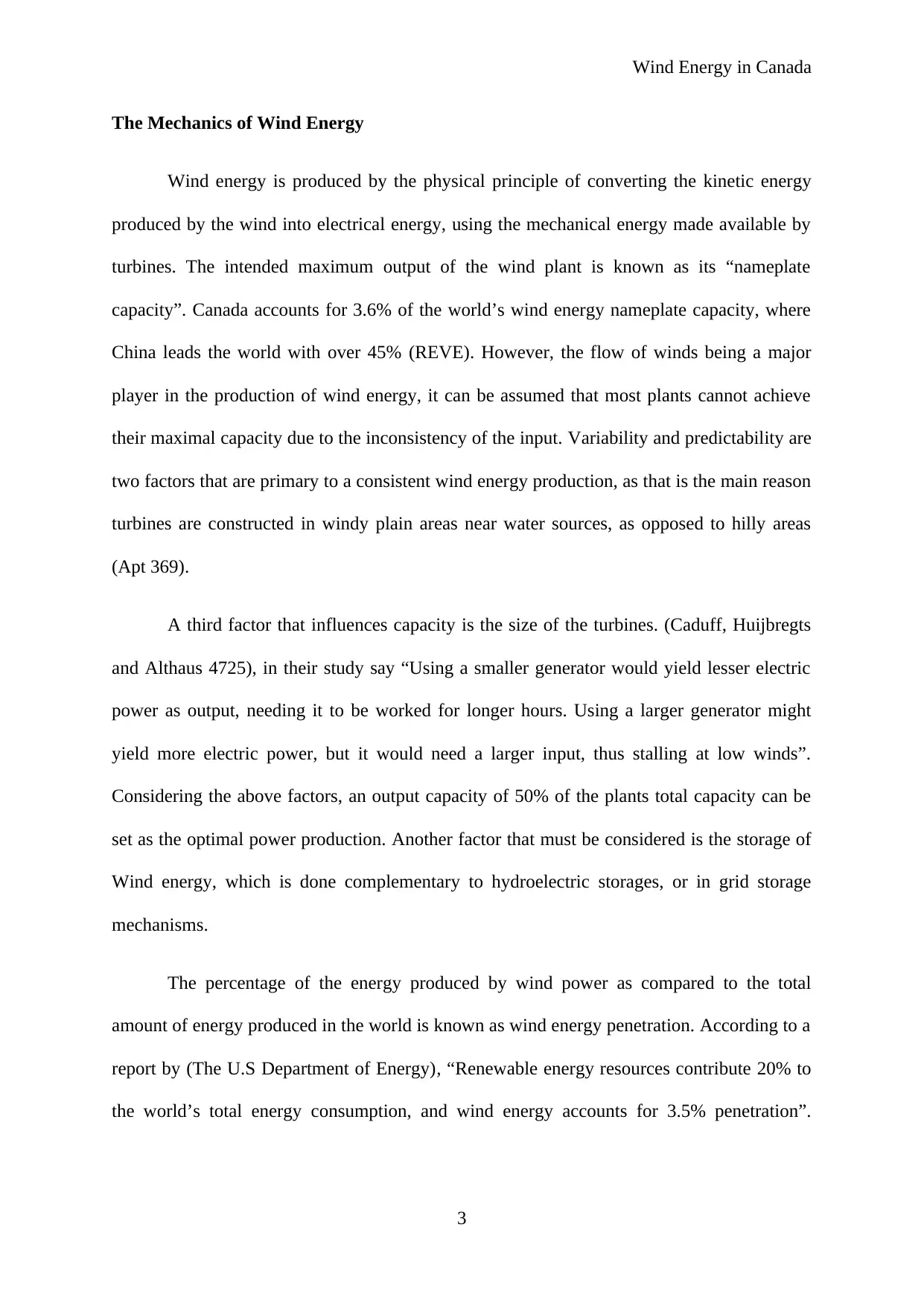
Wind Energy in Canada
The Mechanics of Wind Energy
Wind energy is produced by the physical principle of converting the kinetic energy
produced by the wind into electrical energy, using the mechanical energy made available by
turbines. The intended maximum output of the wind plant is known as its “nameplate
capacity”. Canada accounts for 3.6% of the world’s wind energy nameplate capacity, where
China leads the world with over 45% (REVE). However, the flow of winds being a major
player in the production of wind energy, it can be assumed that most plants cannot achieve
their maximal capacity due to the inconsistency of the input. Variability and predictability are
two factors that are primary to a consistent wind energy production, as that is the main reason
turbines are constructed in windy plain areas near water sources, as opposed to hilly areas
(Apt 369).
A third factor that influences capacity is the size of the turbines. (Caduff, Huijbregts
and Althaus 4725), in their study say “Using a smaller generator would yield lesser electric
power as output, needing it to be worked for longer hours. Using a larger generator might
yield more electric power, but it would need a larger input, thus stalling at low winds”.
Considering the above factors, an output capacity of 50% of the plants total capacity can be
set as the optimal power production. Another factor that must be considered is the storage of
Wind energy, which is done complementary to hydroelectric storages, or in grid storage
mechanisms.
The percentage of the energy produced by wind power as compared to the total
amount of energy produced in the world is known as wind energy penetration. According to a
report by (The U.S Department of Energy), “Renewable energy resources contribute 20% to
the world’s total energy consumption, and wind energy accounts for 3.5% penetration”.
3
The Mechanics of Wind Energy
Wind energy is produced by the physical principle of converting the kinetic energy
produced by the wind into electrical energy, using the mechanical energy made available by
turbines. The intended maximum output of the wind plant is known as its “nameplate
capacity”. Canada accounts for 3.6% of the world’s wind energy nameplate capacity, where
China leads the world with over 45% (REVE). However, the flow of winds being a major
player in the production of wind energy, it can be assumed that most plants cannot achieve
their maximal capacity due to the inconsistency of the input. Variability and predictability are
two factors that are primary to a consistent wind energy production, as that is the main reason
turbines are constructed in windy plain areas near water sources, as opposed to hilly areas
(Apt 369).
A third factor that influences capacity is the size of the turbines. (Caduff, Huijbregts
and Althaus 4725), in their study say “Using a smaller generator would yield lesser electric
power as output, needing it to be worked for longer hours. Using a larger generator might
yield more electric power, but it would need a larger input, thus stalling at low winds”.
Considering the above factors, an output capacity of 50% of the plants total capacity can be
set as the optimal power production. Another factor that must be considered is the storage of
Wind energy, which is done complementary to hydroelectric storages, or in grid storage
mechanisms.
The percentage of the energy produced by wind power as compared to the total
amount of energy produced in the world is known as wind energy penetration. According to a
report by (The U.S Department of Energy), “Renewable energy resources contribute 20% to
the world’s total energy consumption, and wind energy accounts for 3.5% penetration”.
3
⊘ This is a preview!⊘
Do you want full access?
Subscribe today to unlock all pages.

Trusted by 1+ million students worldwide
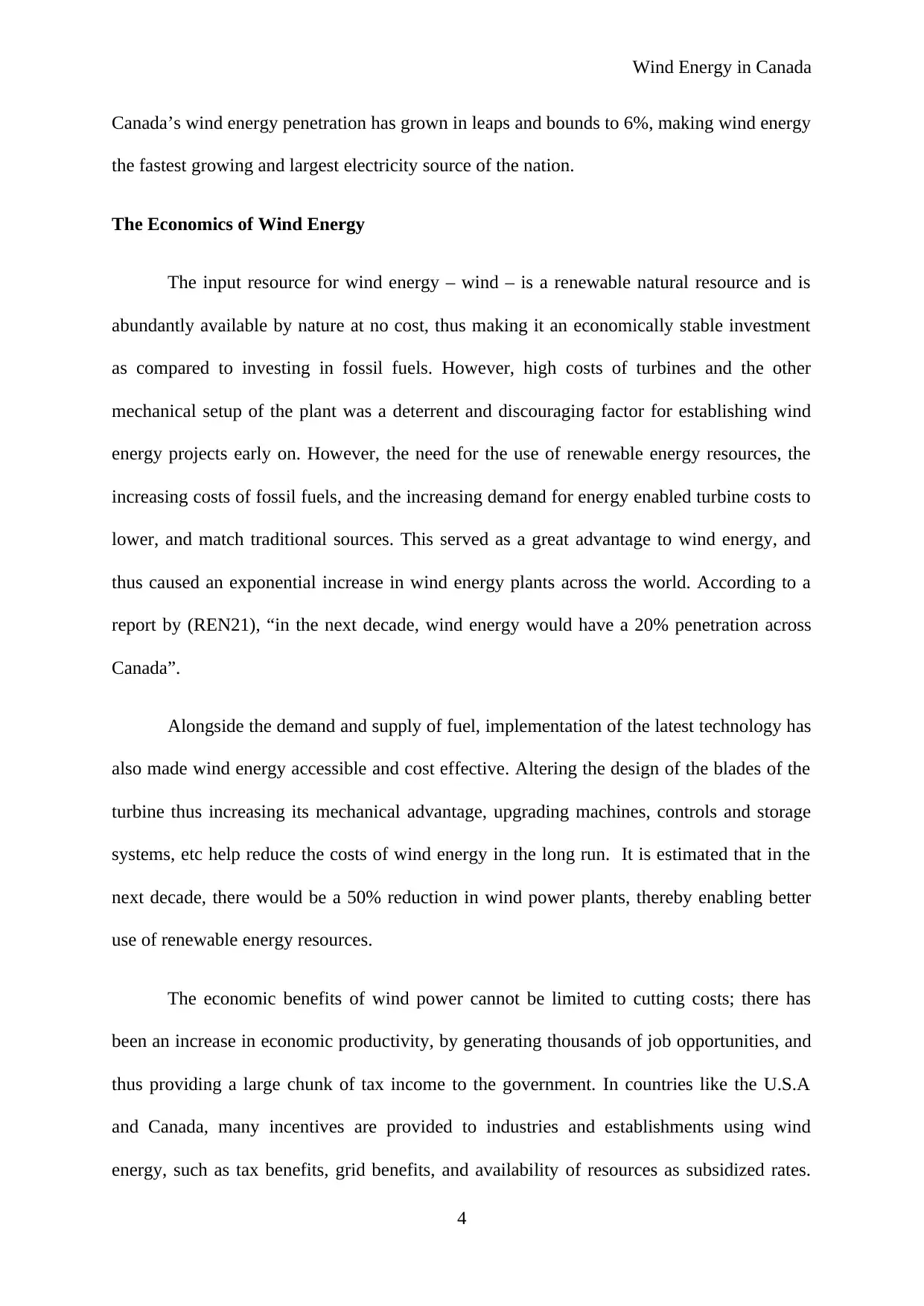
Wind Energy in Canada
Canada’s wind energy penetration has grown in leaps and bounds to 6%, making wind energy
the fastest growing and largest electricity source of the nation.
The Economics of Wind Energy
The input resource for wind energy – wind – is a renewable natural resource and is
abundantly available by nature at no cost, thus making it an economically stable investment
as compared to investing in fossil fuels. However, high costs of turbines and the other
mechanical setup of the plant was a deterrent and discouraging factor for establishing wind
energy projects early on. However, the need for the use of renewable energy resources, the
increasing costs of fossil fuels, and the increasing demand for energy enabled turbine costs to
lower, and match traditional sources. This served as a great advantage to wind energy, and
thus caused an exponential increase in wind energy plants across the world. According to a
report by (REN21), “in the next decade, wind energy would have a 20% penetration across
Canada”.
Alongside the demand and supply of fuel, implementation of the latest technology has
also made wind energy accessible and cost effective. Altering the design of the blades of the
turbine thus increasing its mechanical advantage, upgrading machines, controls and storage
systems, etc help reduce the costs of wind energy in the long run. It is estimated that in the
next decade, there would be a 50% reduction in wind power plants, thereby enabling better
use of renewable energy resources.
The economic benefits of wind power cannot be limited to cutting costs; there has
been an increase in economic productivity, by generating thousands of job opportunities, and
thus providing a large chunk of tax income to the government. In countries like the U.S.A
and Canada, many incentives are provided to industries and establishments using wind
energy, such as tax benefits, grid benefits, and availability of resources as subsidized rates.
4
Canada’s wind energy penetration has grown in leaps and bounds to 6%, making wind energy
the fastest growing and largest electricity source of the nation.
The Economics of Wind Energy
The input resource for wind energy – wind – is a renewable natural resource and is
abundantly available by nature at no cost, thus making it an economically stable investment
as compared to investing in fossil fuels. However, high costs of turbines and the other
mechanical setup of the plant was a deterrent and discouraging factor for establishing wind
energy projects early on. However, the need for the use of renewable energy resources, the
increasing costs of fossil fuels, and the increasing demand for energy enabled turbine costs to
lower, and match traditional sources. This served as a great advantage to wind energy, and
thus caused an exponential increase in wind energy plants across the world. According to a
report by (REN21), “in the next decade, wind energy would have a 20% penetration across
Canada”.
Alongside the demand and supply of fuel, implementation of the latest technology has
also made wind energy accessible and cost effective. Altering the design of the blades of the
turbine thus increasing its mechanical advantage, upgrading machines, controls and storage
systems, etc help reduce the costs of wind energy in the long run. It is estimated that in the
next decade, there would be a 50% reduction in wind power plants, thereby enabling better
use of renewable energy resources.
The economic benefits of wind power cannot be limited to cutting costs; there has
been an increase in economic productivity, by generating thousands of job opportunities, and
thus providing a large chunk of tax income to the government. In countries like the U.S.A
and Canada, many incentives are provided to industries and establishments using wind
energy, such as tax benefits, grid benefits, and availability of resources as subsidized rates.
4
Paraphrase This Document
Need a fresh take? Get an instant paraphrase of this document with our AI Paraphraser
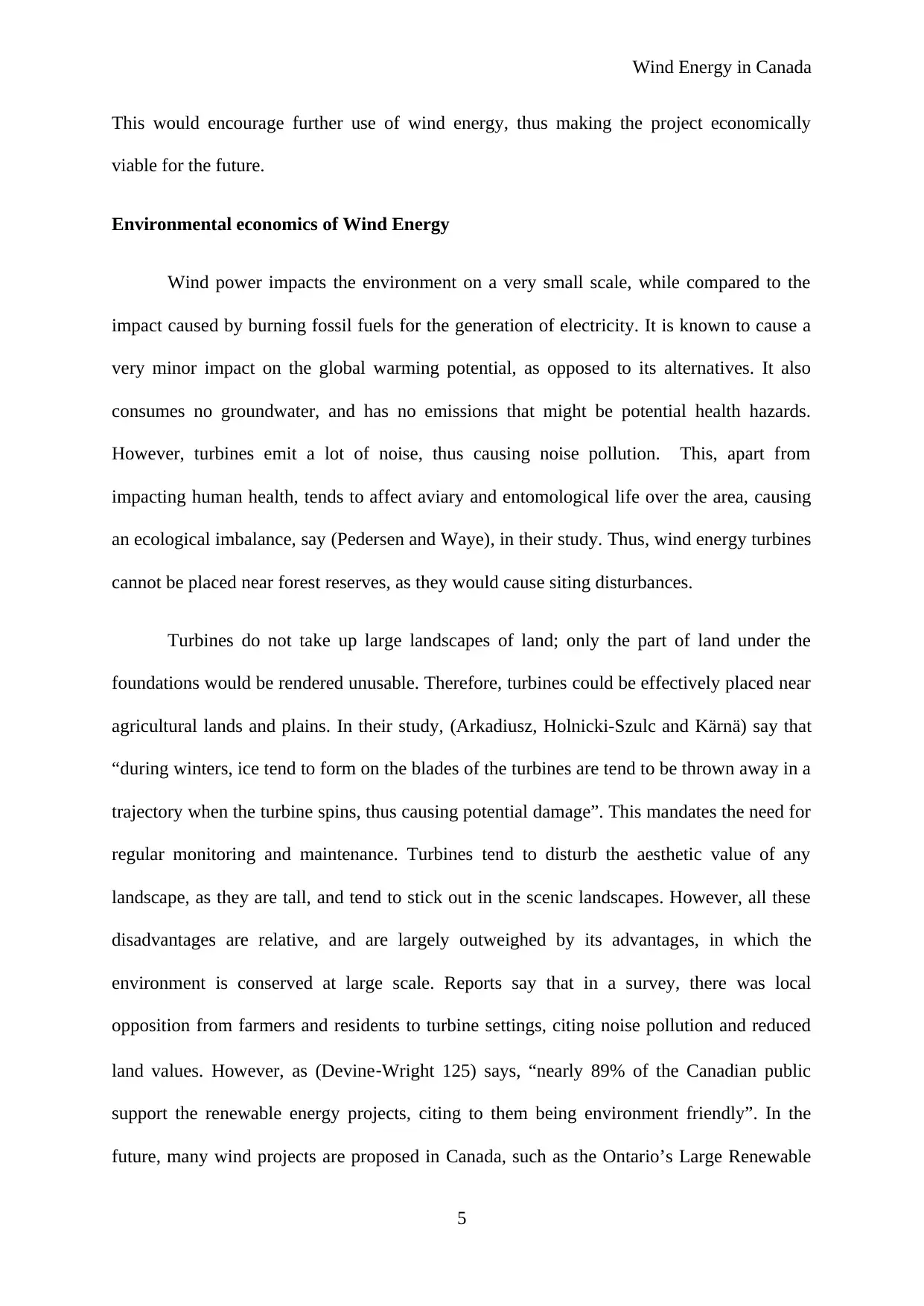
Wind Energy in Canada
This would encourage further use of wind energy, thus making the project economically
viable for the future.
Environmental economics of Wind Energy
Wind power impacts the environment on a very small scale, while compared to the
impact caused by burning fossil fuels for the generation of electricity. It is known to cause a
very minor impact on the global warming potential, as opposed to its alternatives. It also
consumes no groundwater, and has no emissions that might be potential health hazards.
However, turbines emit a lot of noise, thus causing noise pollution. This, apart from
impacting human health, tends to affect aviary and entomological life over the area, causing
an ecological imbalance, say (Pedersen and Waye), in their study. Thus, wind energy turbines
cannot be placed near forest reserves, as they would cause siting disturbances.
Turbines do not take up large landscapes of land; only the part of land under the
foundations would be rendered unusable. Therefore, turbines could be effectively placed near
agricultural lands and plains. In their study, (Arkadiusz, Holnicki-Szulc and Kärnä) say that
“during winters, ice tend to form on the blades of the turbines are tend to be thrown away in a
trajectory when the turbine spins, thus causing potential damage”. This mandates the need for
regular monitoring and maintenance. Turbines tend to disturb the aesthetic value of any
landscape, as they are tall, and tend to stick out in the scenic landscapes. However, all these
disadvantages are relative, and are largely outweighed by its advantages, in which the
environment is conserved at large scale. Reports say that in a survey, there was local
opposition from farmers and residents to turbine settings, citing noise pollution and reduced
land values. However, as (Devine‐Wright 125) says, “nearly 89% of the Canadian public
support the renewable energy projects, citing to them being environment friendly”. In the
future, many wind projects are proposed in Canada, such as the Ontario’s Large Renewable
5
This would encourage further use of wind energy, thus making the project economically
viable for the future.
Environmental economics of Wind Energy
Wind power impacts the environment on a very small scale, while compared to the
impact caused by burning fossil fuels for the generation of electricity. It is known to cause a
very minor impact on the global warming potential, as opposed to its alternatives. It also
consumes no groundwater, and has no emissions that might be potential health hazards.
However, turbines emit a lot of noise, thus causing noise pollution. This, apart from
impacting human health, tends to affect aviary and entomological life over the area, causing
an ecological imbalance, say (Pedersen and Waye), in their study. Thus, wind energy turbines
cannot be placed near forest reserves, as they would cause siting disturbances.
Turbines do not take up large landscapes of land; only the part of land under the
foundations would be rendered unusable. Therefore, turbines could be effectively placed near
agricultural lands and plains. In their study, (Arkadiusz, Holnicki-Szulc and Kärnä) say that
“during winters, ice tend to form on the blades of the turbines are tend to be thrown away in a
trajectory when the turbine spins, thus causing potential damage”. This mandates the need for
regular monitoring and maintenance. Turbines tend to disturb the aesthetic value of any
landscape, as they are tall, and tend to stick out in the scenic landscapes. However, all these
disadvantages are relative, and are largely outweighed by its advantages, in which the
environment is conserved at large scale. Reports say that in a survey, there was local
opposition from farmers and residents to turbine settings, citing noise pollution and reduced
land values. However, as (Devine‐Wright 125) says, “nearly 89% of the Canadian public
support the renewable energy projects, citing to them being environment friendly”. In the
future, many wind projects are proposed in Canada, such as the Ontario’s Large Renewable
5
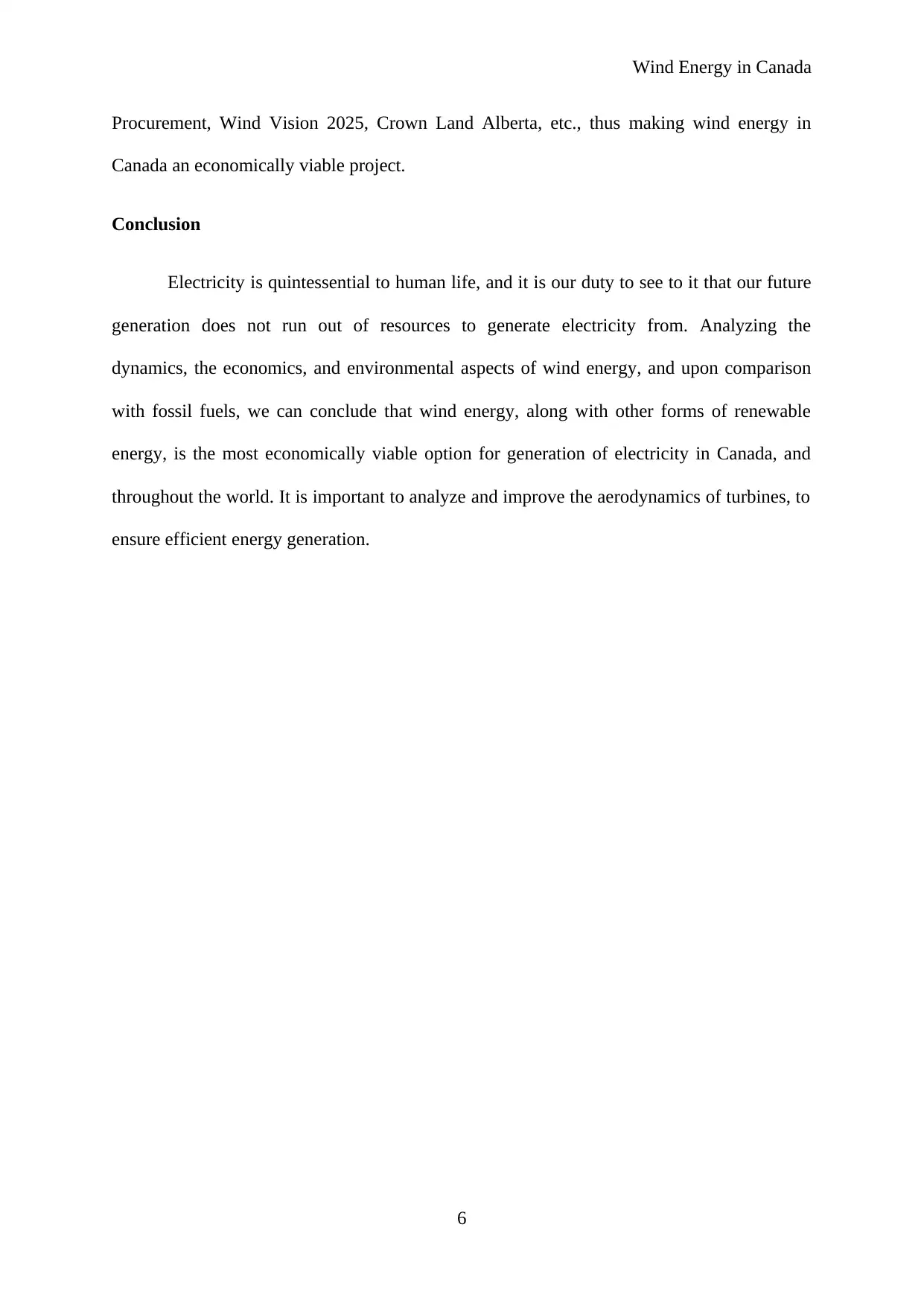
Wind Energy in Canada
Procurement, Wind Vision 2025, Crown Land Alberta, etc., thus making wind energy in
Canada an economically viable project.
Conclusion
Electricity is quintessential to human life, and it is our duty to see to it that our future
generation does not run out of resources to generate electricity from. Analyzing the
dynamics, the economics, and environmental aspects of wind energy, and upon comparison
with fossil fuels, we can conclude that wind energy, along with other forms of renewable
energy, is the most economically viable option for generation of electricity in Canada, and
throughout the world. It is important to analyze and improve the aerodynamics of turbines, to
ensure efficient energy generation.
6
Procurement, Wind Vision 2025, Crown Land Alberta, etc., thus making wind energy in
Canada an economically viable project.
Conclusion
Electricity is quintessential to human life, and it is our duty to see to it that our future
generation does not run out of resources to generate electricity from. Analyzing the
dynamics, the economics, and environmental aspects of wind energy, and upon comparison
with fossil fuels, we can conclude that wind energy, along with other forms of renewable
energy, is the most economically viable option for generation of electricity in Canada, and
throughout the world. It is important to analyze and improve the aerodynamics of turbines, to
ensure efficient energy generation.
6
⊘ This is a preview!⊘
Do you want full access?
Subscribe today to unlock all pages.

Trusted by 1+ million students worldwide
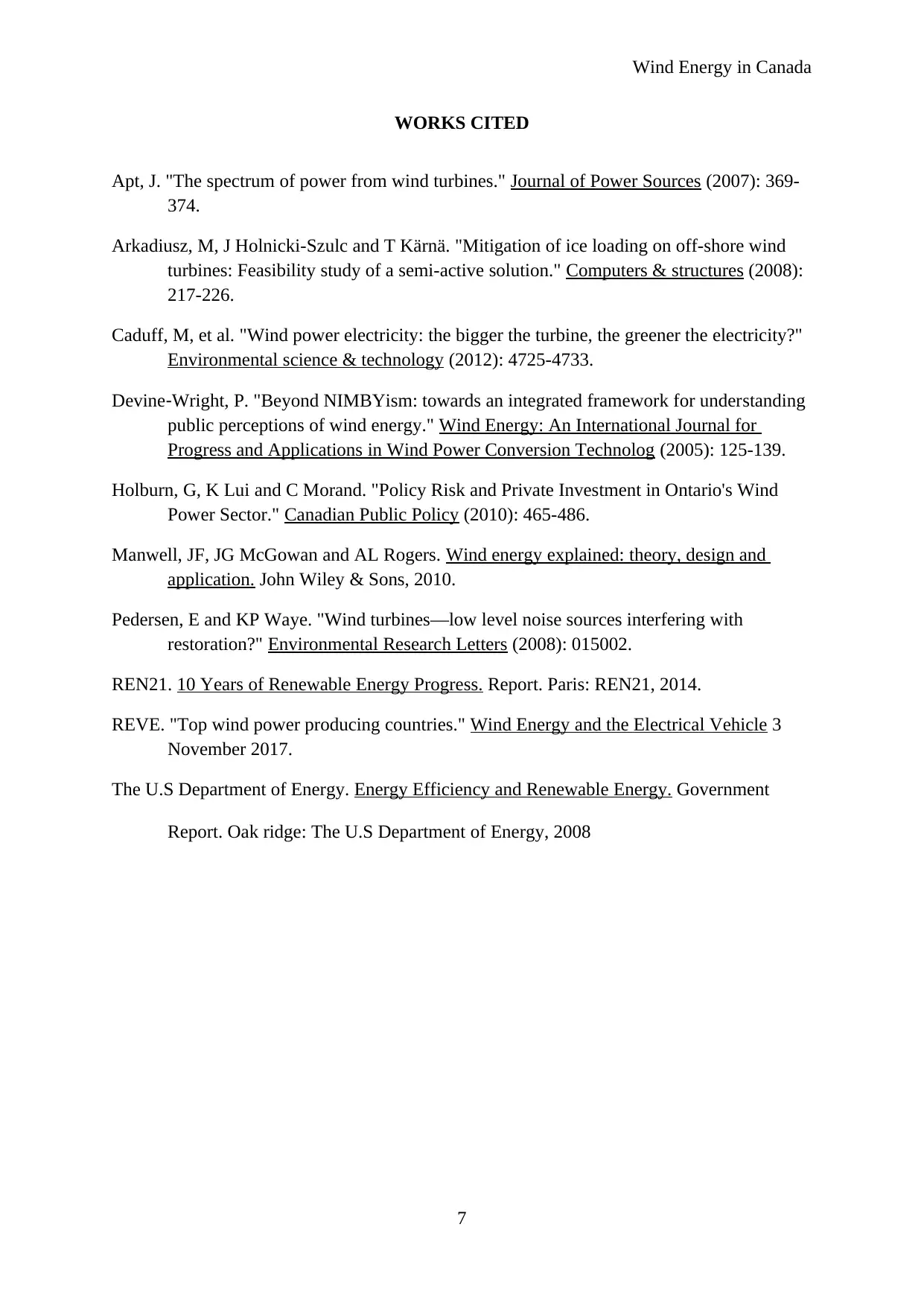
Wind Energy in Canada
WORKS CITED
Apt, J. "The spectrum of power from wind turbines." Journal of Power Sources (2007): 369-
374.
Arkadiusz, M, J Holnicki-Szulc and T Kärnä. "Mitigation of ice loading on off-shore wind
turbines: Feasibility study of a semi-active solution." Computers & structures (2008):
217-226.
Caduff, M, et al. "Wind power electricity: the bigger the turbine, the greener the electricity?"
Environmental science & technology (2012): 4725-4733.
Devine‐Wright, P. "Beyond NIMBYism: towards an integrated framework for understanding
public perceptions of wind energy." Wind Energy: An International Journal for
Progress and Applications in Wind Power Conversion Technolog (2005): 125-139.
Holburn, G, K Lui and C Morand. "Policy Risk and Private Investment in Ontario's Wind
Power Sector." Canadian Public Policy (2010): 465-486.
Manwell, JF, JG McGowan and AL Rogers. Wind energy explained: theory, design and
application. John Wiley & Sons, 2010.
Pedersen, E and KP Waye. "Wind turbines—low level noise sources interfering with
restoration?" Environmental Research Letters (2008): 015002.
REN21. 10 Years of Renewable Energy Progress. Report. Paris: REN21, 2014.
REVE. "Top wind power producing countries." Wind Energy and the Electrical Vehicle 3
November 2017.
The U.S Department of Energy. Energy Efficiency and Renewable Energy. Government
Report. Oak ridge: The U.S Department of Energy, 2008
7
WORKS CITED
Apt, J. "The spectrum of power from wind turbines." Journal of Power Sources (2007): 369-
374.
Arkadiusz, M, J Holnicki-Szulc and T Kärnä. "Mitigation of ice loading on off-shore wind
turbines: Feasibility study of a semi-active solution." Computers & structures (2008):
217-226.
Caduff, M, et al. "Wind power electricity: the bigger the turbine, the greener the electricity?"
Environmental science & technology (2012): 4725-4733.
Devine‐Wright, P. "Beyond NIMBYism: towards an integrated framework for understanding
public perceptions of wind energy." Wind Energy: An International Journal for
Progress and Applications in Wind Power Conversion Technolog (2005): 125-139.
Holburn, G, K Lui and C Morand. "Policy Risk and Private Investment in Ontario's Wind
Power Sector." Canadian Public Policy (2010): 465-486.
Manwell, JF, JG McGowan and AL Rogers. Wind energy explained: theory, design and
application. John Wiley & Sons, 2010.
Pedersen, E and KP Waye. "Wind turbines—low level noise sources interfering with
restoration?" Environmental Research Letters (2008): 015002.
REN21. 10 Years of Renewable Energy Progress. Report. Paris: REN21, 2014.
REVE. "Top wind power producing countries." Wind Energy and the Electrical Vehicle 3
November 2017.
The U.S Department of Energy. Energy Efficiency and Renewable Energy. Government
Report. Oak ridge: The U.S Department of Energy, 2008
7
1 out of 7
Related Documents
Your All-in-One AI-Powered Toolkit for Academic Success.
+13062052269
info@desklib.com
Available 24*7 on WhatsApp / Email
![[object Object]](/_next/static/media/star-bottom.7253800d.svg)
Unlock your academic potential
Copyright © 2020–2025 A2Z Services. All Rights Reserved. Developed and managed by ZUCOL.





